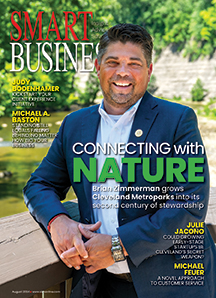Prioritize your people
If customer service is your chosen path to success, then start by laying out expectations at every level of the business.
Heinen uses a service pyramid to illustrate where he wants his employees to be. At the bottom of the pyramid is a category called “nice, respectful.” Just above that is “helpful.” Above that is “knowledgeable,” and above that, at the very tip and where he strives for all employees to be, is “invaluable.” But there’s no silver bullet to get there.
“When people say, ‘What’s your secret?’ — it’s not a program,” he says. “Customer service commitment isn’t a program. It has to be — no matter how many classes you do, no matter how much training you do — woven into the cultural fabric of your organization so that when people come to our organization, they understand.”
It starts with placing a strong emphasis on your people, who, in turn, have to live out that culture. One of the first things you have to do is make sure that you and your company managers are communicating and clarifying on an ongoing basis.
“You have to clarify what your expectations are, and you have to provide feedback,” he says. … “Surveys will tell you that people want to know what their job is and what’s expected of them. They want to know how they’re doing and most companies are bad at both.”
A lot of companies have jobs that aren’t glamorous but are essential to success. The people in them may aspire to greater things, so it’s important to help employees find the roles that are best suited for their personalities and interests.
“The first thing we do is we try to help determine what their passions are, so if they come into work and they’re a cashier and they decide they love the bakery, we’re going to put them in the bakery, because if people are passionate about their work, they’re happier.”
And even if a particular job may not generate passion from anyone, challenge people by keeping their jobs fresh by moving them around.
For example, someone may be a cashier 80 percent of the time, but he or she may take on an extra role of being a customer service facilitator the other 20 percent of the time. In that role, the person would work with both new and seasoned employees, one on one, to help them understand how they can be better at customer service specifically in their department. Or someone may also work as a demo coordinator, so in addition to his or her regular role, he or she would oversee all the demos that go on in the stores.
“It’s not a full-time job, but it’s a way that if someone is interested in doing something different, ‘OK, here’s a way,’” Heinen says. “It could break up the monotony.”
There’s also the tried-and-true method of motivating employees toward customer service: Pay them for it.
Heinen’s supports its employees through a gain-sharing program, which began about three years ago. Each store has set goals, including financial goals, but they’re balanced by overall customer satisfaction scores, known as O-Sat. If the stores meet their goals and their O-Sat score stays at or above their six-month average, they qualify for gain-sharing. If the company makes more than its budget, that money is put into gain-sharing, and the money is split relative to how the store performed compared to other stores — so stores that did better get more money to split among employees.
“Fundamentally, you have to incent the behaviors you want, so we incent the business side,” he says.
It’s possible for one store to make its goals, but that’s not enough — the company has to make its profit goals too.
About half of the time it’s been offered, the employees have reached the levels needed to earn gain-share.
“What it does is it creates a focus in the stores around, ‘What do we have to do?’” he says.
One store really rallied around creating a great customer experience, and it earned gain-share by recording 10 points higher than what it had ever done before, which was a huge accomplishment.
“It can have a significant impact, but at the end of the day, no matter what tools that you put in place, it’s the culture that drives the experience for the customer day-in and day-out,” he says.

